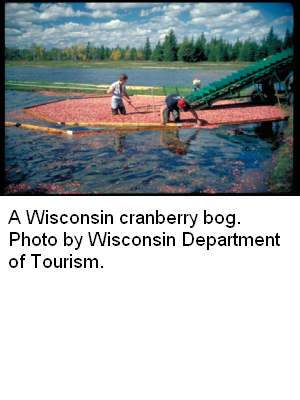
Details
The Cranberry Creek Watershed is located in Juneau and Wood counties. This watershed is made up of very diverse habitats ranging from a bombing range to cranberry marshes. Cranberry Creek Watershed is located a few miles west of Wisconsin Rapids, Port Edwards and Nekoosa. This watershed was ranked using the Nonpoint Source Priority Watershed Selection Criteria. Based on surface and ground water data, the overall ranking is low.
As the name implies, Cranberry Creek Watershed is mainly cranberry marshes. There are 17 to 20 cranberry-growing operations with over 100 cranberry bogs. The DNR lacks information about water quality impacts as a result of surface water discharges from these marshes. There is a concern that nutrients from fertilizers and pesticides/herbicides discharged from these marshes could be degrading water quality and harming sensitive species of aquatic life. Additional research is needed to fill data gaps.
The Juneau County soil erosion control plan listed the Cranberry Creek/Wisconsin Rapids Watersheds as a priority for erosion control and improved irrigation management. According to estimates, nearly all the cropland is eroding at greater than tolerable levels due to wind erosion (Meyer, 1987). There is a potential for groundwater pollution due to the rapid permeability of soils and poor irrigation management (Meyer, 1987).
Date 2002

Ecological Landscapes
The Central Sand Plains Ecological Landscape, located in central Wisconsin, occurs on a flat, sandy lake plain, and supports agriculture, forestry, recreation, and wildlife management. The Ecological Landscape formed in and around what was once Glacial Lake Wisconsin, which contained glacial meltwater extending over 1.1 million acres at its highest stage. Soils are primarily sandy lake deposits, some with silt-loam loess caps. Sandstone buttes carved by rapid drainage of the glacial lake, or by wave action when they existed as islands in the lake, are distinctive features of this landscape.
The historic vegetation of the area included extensive wetlands of many types, including open bogs, shrub swamps, and sedge meadows. Prairies, oak forests, savannas and barrens also occurred in the Ecological Landscape. An area of more mesic forest with white pine and hemlock was found in the northwest portion, including a significant pinery in eastern Jackson County. Today, nearly half of the Ecological Landscape is nonforested, in agriculture and grassland. Most of the historic wetlands were drained early in the 1900s and are now used for vegetable cropping. The forested portion is mostly oak-dominated forest, followed by aspen and pines. A minor portion is maple-basswood forest and lowland hardwoods.
Date 2010
Monitoring & ProjectsProjects including grants, restoration work and studies shown below have occurred in this watershed. Click the links below to read through the text. While these are not an exhaustive list of activities, they provide insight into the management activities happening in this watershed.
Watershed RecommendationsWI Rapids Storm Water Management Plan Update
Date
Status
This project is an installation of nonpoint source best management practices to contribute to the restoration of Wisconsin's waters and was funded by the 319 grant. Storm water planning activities will be undertaken by the municipality and will result in the following products: updated storm water management plan for the developed urban area.
1/1/2016
In Progress
Wisconsin Rapids, Wood County
Date
Status
SSA Planning and Updates for Wisconsin Rapids
4/1/2011
In Progress
 Water Plans and Partnerships
Water Plans and PartnershipsA watershed plan has been updated for this watershed in 2010 and is now available for review.
Date 2010
Watershed History NoteThe Cranberry Creek Watershed in Wood and Juneau counties is home to many cranberry bogs. For countless ages the wild cranberry flourished in many marshy areas of Central Wisconsin. In 1829 Daniel Whitney mentioned the purchase of three canoe loads of cranberries brought down the Yellow River by Indians from the area now known as Cranmoor. During the 1870s a few hardy souls literally carved out by hand the bogs in this area and, in spite of many hazards such as fires and lack of water, succeeded in establishing a new crop. With time the native vines were supplanted by higher producing selections which have given some of the highest yields per acre in the nation. At the turn of the century hand-picking predominat¬ed. Later, improved rakes replaced the colorful family groups together with their nightly entertainment. Today the machine has replaced hand labor in the operation of the bogs, and many of the simple pleasures and intimate associations accompa¬nying the laborious tasks of the cranberry bogs are now only memories of the past.
Date 2010